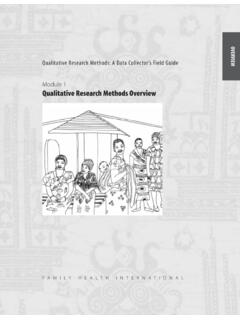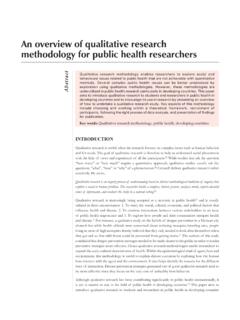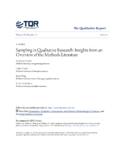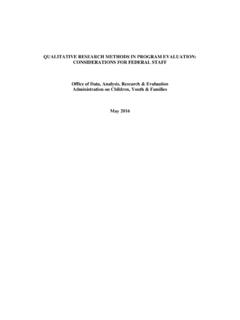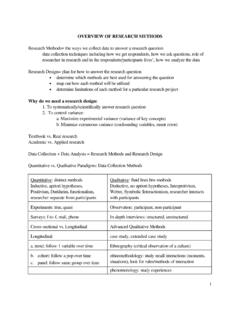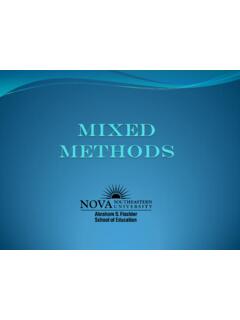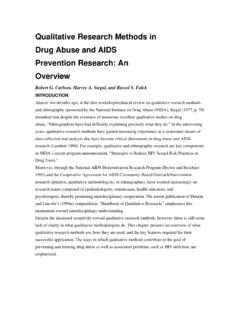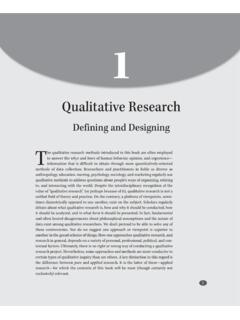Transcription of A Critical Review of Qualitative Research Methods in ...
1 Journal of Education and Practice ISSN 2222-1735 (Paper) ISSN 2222-288X (Online) , , 2016 119 A Critical Review of Qualitative Research Methods in Evaluating Nursing Curriculum Models: Implication for Nursing Education in the Arab World Dr. Briliya Devadas Fatima College of Health Sciences,Institute of Applied Technology, Abu Dhabi, UAE Abstract Aim: The purpose of this Critical literature Review was to examine Qualitative studies done on innovative nursing curriculums in order to determine which Qualitative Methods have been most effective in investigating the effectiveness of the curriculum and which would be most appropriate in an Arab Islamic country.
2 Data Sources: At least 25 studies from major countries in the world were evaluated. To select the required studies, an exhaustive search was conducted in MEDLINE, CINAHL, Academic Search Premier, ERIC, ProQuest, Education Research Complete and Professional Development Collection. Review Methods : The articles were critically reviewed based on the Research methodology selected, the theoretical frameworks that support the methodology and the data collection Methods used to collect data. Discussions: Among the Research methodologies examined, phenomenology in its descriptive form has been extensively used. The second most common design seen was grounded theory and this was appropriate as the phenomenon of innovative nursing curriculum in the Arab region being in its infancy, nurse researchers were interested in generating theory related to the phenomenon of interest.
3 Of the Research methodologies scrutinized, semi-structured interviews and focus group interviews, emerged as the most commonly used data collection tool. Conclusion: Qualitative Research studies have contributed to a great extend to our understanding of innovative nursing curriculum designs. However there is an acute paucity of nursing education and nursing curriculum studies from the Arab world which need to be addressed soon. Keywords: Nursing Education, Nursing curriculum, Qualitative Research , Qualitative Research design and methodology 1. Introduction The nursing curriculum today has undergone tremendous changes from its humble beginnings in 1850 when the first nursing schools opened in the UK. Giddens and Brady (2007) report on this evolution of nursing curriculum and cite contributing factors like the shift from an industrial age to an information age and global changes in the health care delivery system.
4 By the late 1940s, Tyler s curriculum model, which focused on prescribed curriculum development products such as measurable objectives (NLN, 2003), was the framework that nurses used in their educational process. This framework, which at first was thought to be effective in lending structure and shape to the body of knowledge that was nursing, later proved to be a means for content saturation (Giddens & Brady, 2007). By 2001, NLN recognized the limitations and in their position statement (National League for Nursing, 2003, ) challenged faculty to think in new ways, integrate Research findings into their approaches to teaching and evaluating students, and consider different curriculum models . Responding to these and other factors such as globalization, global nursing shortage, technological revolution and the changing health care environment, nurse educators have begun to develop innovative, interactive and student centered curriculum designs (Candela & Benzel-Lindley 2006; Diekelmann 2005; Ironside 2005; Stanley & Dougherty 2010).
5 The purpose of this paper is to critically Review Qualitative studies use in innovative nursing curriculum Research in order to determine which studies have been most effective in investigating the effectiveness of the curriculum and which would be most appropriate in an Arab Islamic country. Twenty seven studies from major countries in the world have been evaluated. The articles have been critiqued based on the Research design selected, the Research methodology adopted and the data collection Methods used to collect data. To select the required studies, an exhaustive search was conducted in MEDLINE, CINAHL, Academic Search Premier, ERIC, Proquest, Education Research Complete and Professional Development Collection. Out of the twenty seven studies selected, the majority of the studies (10) was conducted in the United States, seven studies emerged from UK, two each originated from Canada, Israel and Ireland, and one each was identified from China, Sweden, South Africa and Jordan.
6 The majority of the articles focused on an organizational approach, such as the article titled Curriculum infusion to promote nursing student wellbeing by Yearwood and Riley (2010), while a select few approached the issue from a cultural perspective, for example, teaching reflection to nursing students (O Conner & Hyde, 2005). 2. An overview of Qualitative Research in Nursing Curriculum According to Glesne (2006, p. 4), Qualitative Research Methods are used to understand phenomena from the Journal of Education and Practice ISSN 2222-1735 (Paper) ISSN 2222-288X (Online) , , 2016 120 perspectives of those involved, to contextualize issues in their particular socio-cultural-political milieu, and sometimes to transform or change social conditions.
7 This is particularly relevant for new curriculum models in the nursing profession which seek to address changing societal health care needs while meeting stakeholders expectations and ensuring rigorous standards. According to Maxwell in1998 (cited in Best & Kahn, 2003), there are five components to a Qualitative Research and since it is beyond the scope of this paper to satisfactorily critique all five components, it has been decided to critically scrutinize the Research designs and methodologies alone. In accordance with the National League for nursing (2001), a plethora of Qualitative researches in innovative nursing curriculum started to originate as is evident in the table below which lists select major studies chronologically. Qualitative Research Designs Research designs are an integral part of the study process and as such there must be a good fit between the problem to be studied and the overall framework.
8 In thirteen of the studies listed above in Table 1, the authors have failed to explicitly state what the nature of the design is; simply stating that it is Qualitative -descriptive or exploratory. Sandelowski (2000, ) argues that a Qualitative descriptive design is the method of choice when straight descriptions of phenomenon are desired . He explains that many phenomenological, narrative and ethnographic studies are actually Qualitative descriptive studies with narrative, phenomenological and ethnographical overtones. It is not clear whether this was the reason for the authors reporting the Research design as such or whether innovative curriculum models being a mostly unchartered territory, the authors weren t adequately educated or trained in the theoretical frameworks they were using.
9 Examination of the articles revealed that the purpose in most of the studies was to find out the experiences of the students and faculty involved in the innovative model as shown in the study done by Grealish and Ranse (2009) titled, An exploratory study of first year student s learning in the clinical workplace , and hence these have been critiqued as phenomenological or quasi-phenomenological studies. Phenomenology It is evident from Table 1 that the majority of the authors have employed the phenomenological Research tradition in formulating their study. Descriptive phenomenology is the appropriate design of the study if there is very little or nonexistent available literature on the phenomenon of interest. This holds true in nursing where innovative curriculum models have only just started to develop in the last ten years and is evidently the reason for 14 studies out of the 27 listed, appropriating exploratory or descriptive phenomenology as a Research design in their study.
10 Polit and Beck (2006) report that descriptive phenomenological studies often include four steps: bracketing (whereby the investigator prevents personal beliefs and opinions from contaminating data), intuiting (in which the researcher opens up to new meanings), analyzing (through which new themes are identified) and describing (when the author understands and attempts to define the phenomenon). In all of the 14 studies examined, only Nickerson and Resick (2010) mention bracketing being taken into consideration in planning the study while Child and Langford (2011) and Ritchie et al. (2010) report on an independent interviewer and Research assistants conducting the respective interviews in their studies. Intuitiveness is not explicitly stated in any of the articles but it can be implied from the researchers sincere aim in incorporating new models and using a Qualitative approach to determining its success.










